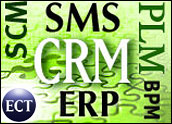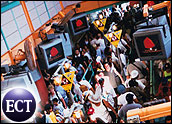
According to a February JupiterResearch survey, 59 percent of small businesses that generate between US$100,000 and $5 million in annual revenue and 74 percent of those making in excess of $5 million are heavy users of mobile phones. Whether they work on their own or have 100 employees, more than half of small businesses rely on mobile phones.
This boundary-less access to the business is not without benefit. A December 2005 study by Aberdeen Group — “New Fleet Mobile Strategies” — noted a 13 percent improvement in corporate productivity thanks to mobile accessibility. It rises to a 15 percent increase among best-in-class companies.
Staying in Control
“I’m staying ahead of the competition, sending proposals, making and fielding phone calls, controlling the business — not letting it control me and my time, activities or location,” says Jeff Rosengarden, CEO of Skokie, Ill.-based HighTower, Inc.
In order to work sales leads in his business software development firm, he and mobile-enabled HighTower salespeople manage their time through mobile devices, which track calls scheduled through their CRM package. “We are dependent on our CRM package, so it communicates with all mobile office products,” he says.
HighTower is not only a mobile-dependent small businesses, it sells solutions to them as well. The Sage CRM SalesLogix packages feature sales lead tracking with business alerts initiated by scans of a company’s CRM server. Three-day-old leads, for example, are re-sent with warnings to the assigned sales rep, prompting him or her to activate the lead. If nothing is communicated to the server by the mobile salesperson in seven days, the rep and his or her sales manager receive an alert.
Productivity Needs Process Adaptation
For some small businesses, reliance on mobile phones and other technology enables their establishment but allows entrepreneurs to have lives outside of the office, too. For others, it affords them larger sales forces without scattered leased office space, land lines and additional location-based software licenses. Small businesses with stable histories may desire increased revenues and quicker product turnover.
Mobile devices have the potential to achieve competitive results. However, as the escalating nature of HighTower’s available CRM services proves, not all mobile workers use the tools to their potential.
“You’re building on or adding a new dimension to the sales process” through mobile-enabled workforces, says Rodger Stotz, vice president and managing consultant of Maritz Inc., located in Fenton, Mo. “But one of the things we’re seeing is that the technology is ahead of the actual application. The skill level of the sales force logging in is not fully exploiting the technology.”
One of the reasons is that some sales organizations engage mobile tools expecting them to magically deliver an accelerated sales cycle, more satisfied and loyal customers, bigger sales orders or any other measure of improved productivity. Their failure to train the sales force and clearly define management’s new expectations of reps leaves mobile workers lacking a full understanding of the resources they have at hand, Stotz says.
Productivity gains start before the rep takes or makes a customer call. It starts with responsible sales management, “whether the corporate expectation of a mobile workforce is huge product movement, cost-savings or exponential sales improvement,” he says.
Teaching Technology
Sales management needs to determine how best to embed the skills required to make the most of new technology. “It takes time, and salespeople generally are not patient about taking time out of selling to do training,” Stotz says.
“Whenever you change methods, things aren’t in the same place they were,” he continues. Organizations may experience a decrease in sales productivity and disappointing results while salespeople balk, “we used to do it this way. How come it’s not working that way?” They have to spend time and learn the functionality of the mobile-enabled applications.
Then, once the sales force goes mobile and experiences the applications, internal expectations about its returns may need to change. Similarly, customers’ expectations of 24/7 service may need to be tempered with the capability of the enterprise systems to deliver data to mobile workers.
“Each sales force ought to expect that as it is making major steps in deployment of technology, there may be a dip in performance before there are sales performance gains,” Stotz says. “Mobile workforces are in the early stages. There is a gap between the promise and what is occurring. The sales force needs to change its methodology in the field to adopt new technology.”






















































Social CRM
See all Social CRM